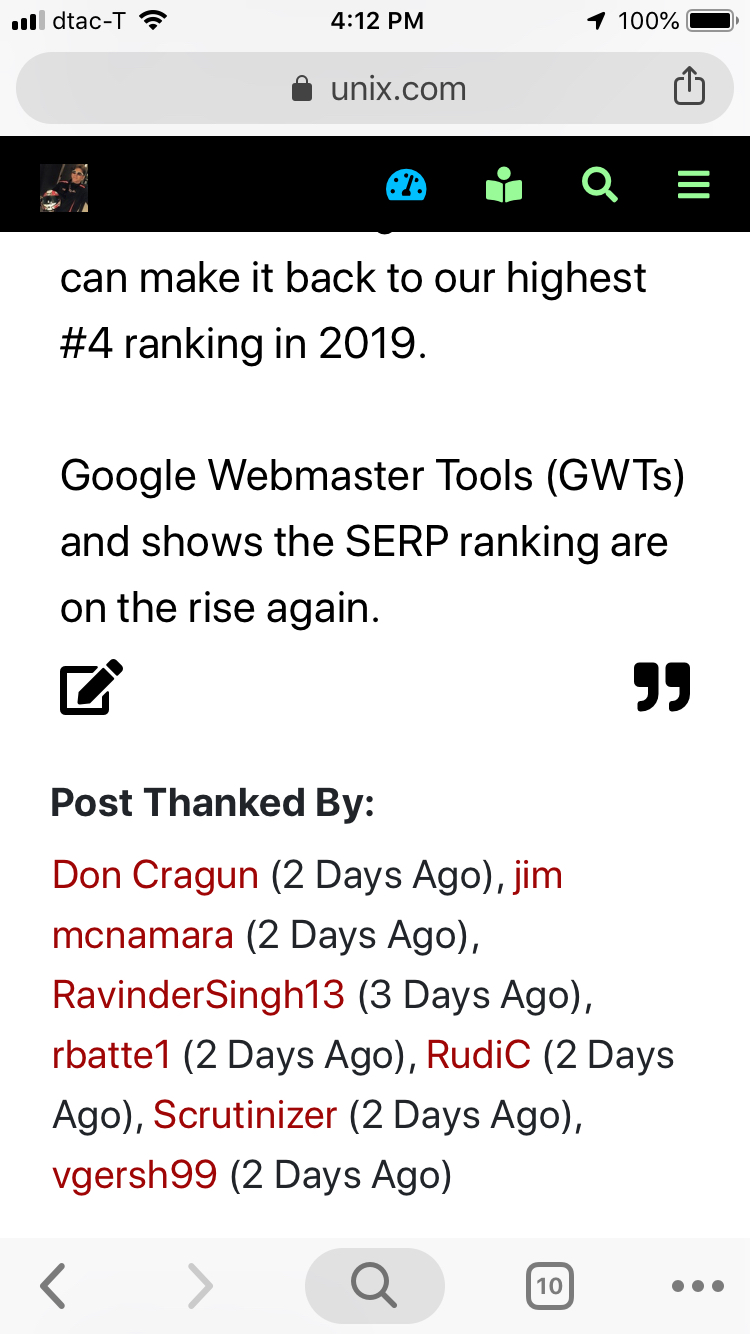|
|
Sponsored Content
The Lounge
What is on Your Mind?
Mobile Thanks Now Visible in Mobile
Post 303028664 by Neo on Saturday 12th of January 2019 04:17:01 AM
|
|
4 More Discussions You Might Find Interesting
1. SuSE
can anyone tell how to install (load) linux OS on my mobile (1 Reply)
Discussion started by: daya.pandit
1 Replies
2. What is on Your Mind?
Do we have a mobile app for unix.com? (1 Reply)
Discussion started by: ahamed101
1 Replies
3. What is on Your Mind?
RE:
https://www.unix.com/what-is-on-your-mind-/280775-thanks-button-coming-mobile-soon.html
Now, the "Thank You" icon is working on mobile so all registered members can "give thanks" on mobile.
Seems to work fine. (2 Replies)
Discussion started by: Neo
2 Replies
4. UNIX for Advanced & Expert Users
Hello Folks,
I need to send the output from shell script to range of mobile phones based on their msisdn . Is there any open source solution could help me to do so from CentOS or redhat ?? (11 Replies)
Discussion started by: arm
11 Replies
LEARN ABOUT HPUX
rtradvd
rtradvd(1M) rtradvd(1M) NAME
rtradvd - Router Advertisement daemon for IPv6 SYNOPSIS
configfile] debuglevel] pidfile] [debugfile] DESCRIPTION
the router advertisement daemon for IPv6, implements router functionality as specified by RFC 2461 ("Neighbor Discovery for IP Version 6"). The daemon listens to router solicitation and sends router advertisement messages on demand and periodically as described in "Neighbor Dis- covery for IP Version 6". These advertisements allow any listening host to configure their addresses and some other parameters automati- cally without manual intervention. They can also choose a default router based on these advertisements. Router advertisement is configured on a per interface basis, as described in rtradvd.conf(4). The "PRIVATE" flag on each interface must be cleared in order to enable sending Router Advertisement packets out on that particular interface as described by ifconfig(1M). The daemon does not listen on an interface when the "PRIVATE" flag is set. also implements four new Mobile IPv6 ICMPv6 message types, two for use in the dynamic home agent address discovery mechanism, and two for mobile configuration mechanisms. These four new ICMPv6 messages are activated if "Home Agent Flag" (see rtradvd.conf(4)) is enabled on any configured interface and the daemon detects the Mobile IPv6 kernel module during startup (see mip6mod(7)) or via mip6admin(1M) utility. In this case, sends the list of prefixes configured with the "Router Address Flag" set to allowing the node to act as a home agent on all the links corresponding to these prefixes (see rtradvd.conf(4)). Options Specifies that the configuration file will be parsed for syntax errors and coherency. Any syntax error or incoherency data is printed to will exit with a status 1 if there were any errors or 0 (zero) if there were not. All other command line options except are ignored. Use a configuration file other than Print debugging information. If debugfile is not specified, the daemon stays in foreground mode. A number after the determines the level of messages printed. The level must be an integer in the range from 1 to 10, with higher numbers resulting in greater detail in debug messages. Disable printing the inconsistency information via syslog(3C) in router advertisement messages received from other routers on the link. Use a pid file other than debugfile Specifies a debug file in which to place debug information. If a debug file is specified on the command line, detaches from the terminal and runs in the background. Otherwise, assumes that debugging is desired to stderr and remains in the foreground. The daemon includes Mobile IPv6 options in Router Advertisement messages when the configuration file contains the specific Mobile IPv6 key- words (see rtradvd.conf(4)). The daemon can be started during boot-time initialization. To do so, see for entries. The following signals have the specified effect when sent to the server process using the kill(1) command: causes to read the configuration file and reload the database. If the configuration file contains an error or inconsistency, the daemon continues with the old configuration database. The file should be checked for errors. terminates gracefully. In this case, before exiting, will transmit router advertisement with Router Lifetime 0 to all the listen- ing interfaces. This can take up to 10 seconds. DIAGNOSTICS
Any errors encountered by in the configuration file, or in normal operation are logged via syslog(3C). NOTE
The following ICMPv6 types are assigned for Mobile IPv6: Home Agent Address Discovery Request: ICMPv6 type 144 Home Agent Address Discovery Reply: ICMPv6 type 145 Mobile Prefix Solicitation: ICMPv6 type 146 Mobile Prefix Advertisement: ICMPv6 type 147 Refer to the for information on configuring Virtual IPv6 Anycast addresses. AUTHOR
was developed by HP. FILES
The default configuration file Process ID of running To enable at system initialization. SEE ALSO
kill(1), ifconfig(1M), mip6admin(1M), syslog(3C), rtradvd.conf(4), mip6mod(7), ndp(7P). 1. T. Narten, E. Nordmark, W. Simpson, RFC2461, December 1998. 2. S. Thompson, T. Narten, RFC2462, December 1998. 3. D. Johnson, C. Perkins, IETF document. rtradvd(1M)
